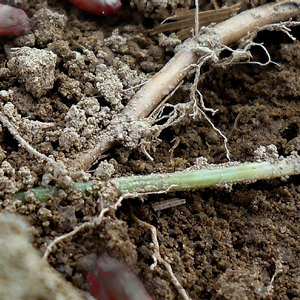Contact
Andong Shi
Post doc at the Department of Soil and Environment
andong.shi@slu.se

Differences in the soil composition cause different rates of decomposition of microbial organisms. As four times more carbon is stored in soils than in the vegetation it is very important to investigate how carbon compounds is broken down. In order to do that researchers have tested how spatial heterogeneity affect carbon decomposition using plastic cylinders and heat as a proxy for soil microbial activity.
Soil organic carbon (C) regulates many ecosystem functions, and the decomposition of organic C is of great importance. Yet, the heterogeneous nature of soil matrix makes the understanding of C decomposition complicated.
– We manipulated a gradient of substrate spatial heterogeneity and investigated its role in C decomposition, says Andong Shi, one of the researchers behind this study.
Four times more the amount of C (3000 Pg) is stored in soils than in the vegetation globally, thus soil C flux strongly regulates ecosystem functions, such as biogeochemical cycling and climate change mitigation. Moreover, soil matrix is highly heterogeneous, and is due to the arrangement of minerals, organic matter, water and gas, which creates different microbial habitats varying in size, hence differing in substrate accessibility and concentration. Such heterogeneity results in different microbial decomposition rate, but the detailed investigation is limited.
We tested the effects of substrate spatial heterogeneity on microbial activities by manipulating a gradient of substrate accessibility and concentration using a custom-made cylinder by 3D printing (see the illustration below). Each cylinder was designed with an inner cross to divide the system into four compartments of equal volume. Same total amount of glucose was added either to a single compartment (referred to as 100%), to two compartments (referred to as 50%), or to all four compartments (referred to as 25%), thus created the most, intermediate heterogeneous treatments and the most homogeneous treatment, respectively. Samples were incubated in isothermal calorimeters to monitor soil heat dissipation rates as proxy of soil microbial activity.
Will the effect of substrate spatial heterogeneity disappear if such heterogeneity is reduced (via allowing substrate to diffuse)?
– To investigate that, the diffusion of spatially heterogeneous substrates on microbial activities outlined above, the experiment was repeated in another set of cylinders in which a cross-shaped mesh was printed to allow substrate diffusion between compartments, says Andong.
The results were that substrate spatial heterogeneity not only decreases decomposition, but also delayed the maximum microbial activity, despite the same amount of substrate per treatment. When substrates are allowed to diffuse among compartments, the most heterogeneous treatment had similar decomposition rate compared to the most homogeneous treatment.
– The results highlight the role of spatial heterogeneity in influencing C decomposition. This should really be taken into account in carbon earth models in the future. Currently, the manuscript of this work is under review in Soil Biology & Biochemistry, concludes Andong.
Andong Shi
Post doc at the Department of Soil and Environment
andong.shi@slu.se